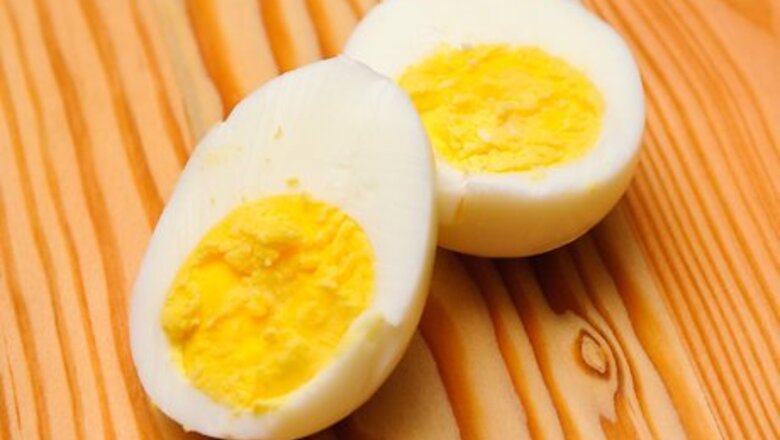
views
Choosing Healthy Cooking Options
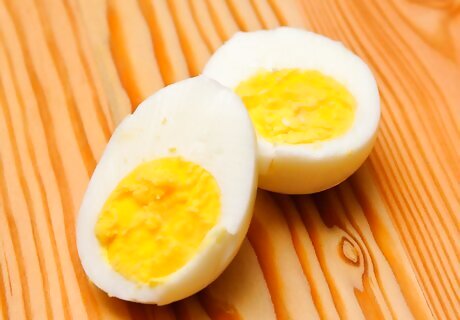
Boil your eggs. Boiling an egg protects the nutrients contained in the yolk from oxidation and is an easy, healthy option for preparing a meal or snack. Simply place the egg in a pot of boiling water and remove it once the egg has hardened to your preference. Depending on your stovetop, a soft-boiled egg usually takes between 3 and 6 minutes. A hard-boiled egg typically takes 10 to 15 minutes. Boiled eggs are a great breakfast option and make a tasty addition to many types of salads. Hard-boiled eggs are a great option for egg and potato salads. You can also add hard-boiled eggs to a nutritious cobb salad.

Poach an egg. Poaching is another healthy option for cooking your eggs. Simply crack your eggs into a shallow pan of water and simmer the eggs for 3 to 5 minutes. You may also choose to add 1 to 2 tablespoons (15 to 30 milliliters) of vinegar to the simmering water to help the eggs set properly. To avoid Salmonella, you should always choose fresh eggs when poaching. To test for freshness, place your eggs in a bowl of water. If it is fresh, the egg will sink. If it is past its prime, the egg will bob or float. Poached eggs are a great breakfast option. They are particularly popular in eggs benedict.
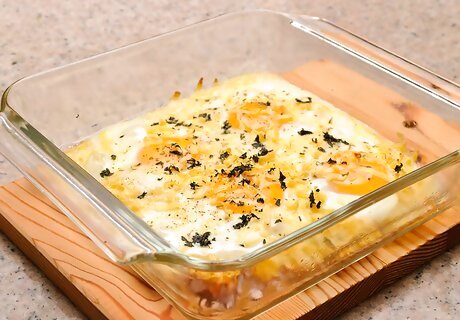
Bake your eggs. If you want to cut down on the amount of oil that you use to cook your eggs, consider baking them. Simply place the eggs in a greased or non-stick pan, add healthy toppings, and bake the eggs for about 10 to 15 minutes at 325 degrees Fahrenheit (165 degrees Celsius). This method limits the amount of unhealthy fats that you will eat from cooking oils. To promote your overall health, consider using a non-stick pan. Otherwise, you may need to add calories by using cooking spray, butter, or ghee to grease the pan. Shakshuka is a healthy baked egg breakfast common throughout North Africa and the Middle East.

Fry your eggs in healthy oils. If you really enjoy fried eggs, consider using healthy cooking oils and butters. Ghee and clarified butter may be healthier alternatives to regular butter or margarine. If you like the taste, a small amount of coconut oil is also a good frying option because it does not oxidize at high heat. Consider using a non-stick pan to limit the amount of oil that you need to fry your eggs.
Serving Eggs with Healthy Accompaniments
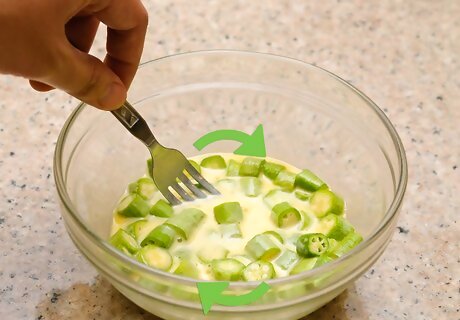
Add more vegetables. If you want to spruce up your egg dishes, consider adding more vegetables. Onions, tomatoes, mushrooms, spinach, peppers, and avocados will add flavor and healthy vitamins and nutrients to your egg dishes. You can add raw vegetables to an omelette or eat them as a side with your eggs. Salsa is a healthy option that can add a lot of flavor to your eggs. Make a simple, veggie-packed scramble by adding some spinach, sweet peppers, and diced onions to your eggs as you scramble them. The dish will cook together and create a delicious and nutritious meal.

Choose lean meats. Instead of serving your eggs with meats that are high in saturated fat, pick lean meats that are healthy sources of protein. Turkey, bacon, or chicken sausages can be a healthy alternative to pork sausage and bacon. However, they can be higher in sodium. You can also trim the excess fat from your meats to make them healthier. For example, if you make a Cobb salad, consider using turkey bacon instead of traditional pork bacon. As a rule of thumb, try to limit the amount of cured meats you eat. Try not to eat more than two slices of bacon or two sausage links with your breakfast.

Eat whole grains. If you are looking for a healthy carbohydrate to add to your egg dish, look for whole grains. Grains like rice and quinoa will help you stay full and are a healthy source of energy to fuel your day. You might also want to consider sprouted grain breads made from wheat, barley, rye, oats, millet, or brown rice. These breads may provide some protein and often have a low caloric content. Consider making a delicious quinoa egg bake to get some healthy protein and whole grains.
Making Healthy Choices

Avoid overcooking your eggs. The longer that you cook your eggs at a high temperature, the more likely you are to lose important nutrients. Depending on the preparation method, the amount of time needed to cook the egg properly will vary. Depending on how runny your like your yolks, frying an egg can take 2 to 5 minutes. Poaching an egg should take about 3 minutes. Baking an egg can take 10 to 15 minutes. Boiled eggs can take anywhere from 5 to 15 minutes depending on your preference.

Limit the amount of cheese you serve with your eggs. In order to avoid unhealthy saturated fats, you might want to skip egg dishes that contain a lot of cheese. Instead, look for cheese substitutes, like nutritional yeast or avocados, to add flavor to your eggs. If you are adding cheese to your eggs, try to limit the cheese to 2 tablespoons (30 grams) per serving.

Skip the yolk. If you are looking to limit the amount of fat and calories that you ingest, you might want to skip the yolk, which contains the majority of an eggs caloric content. Instead, separate the yolks and cook the egg whites. However, by skipping the yolk, you miss many of the important vitamins and minerals contained in eggs. In fact, there is some evidence that egg yolk contains nutrients that can help control your weight. You can also buy already-separated egg whites at your local grocery store.
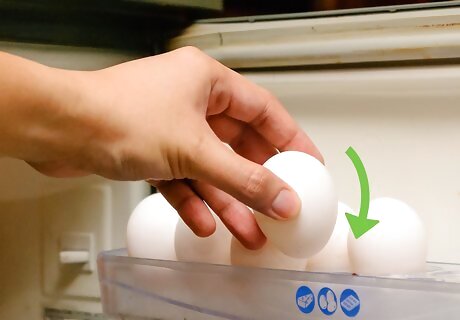
Reduce your risk of foodborne illness. Eating eggs raw can lead to a Salmonella infection. Keep your eggs refrigerated at 40 degrees Fahrenheit (4 degrees Celsius) and only buy eggs from stores and suppliers that refrigerate them. When cooking eggs, heat until both the yolk and white are firm and they reach an internal temperature of 160 degrees Fahrenheit (71 degrees Celsius). Do not keep eggs or dishes made from eggs warm or at room temperature for more than an hour. Wash your hands and any surfaces or utensils that can into contact with raw eggs. Throw away any cracked or dirty eggs. Buy pasteurized eggs and egg products.

Finished.



















Comments
0 comment